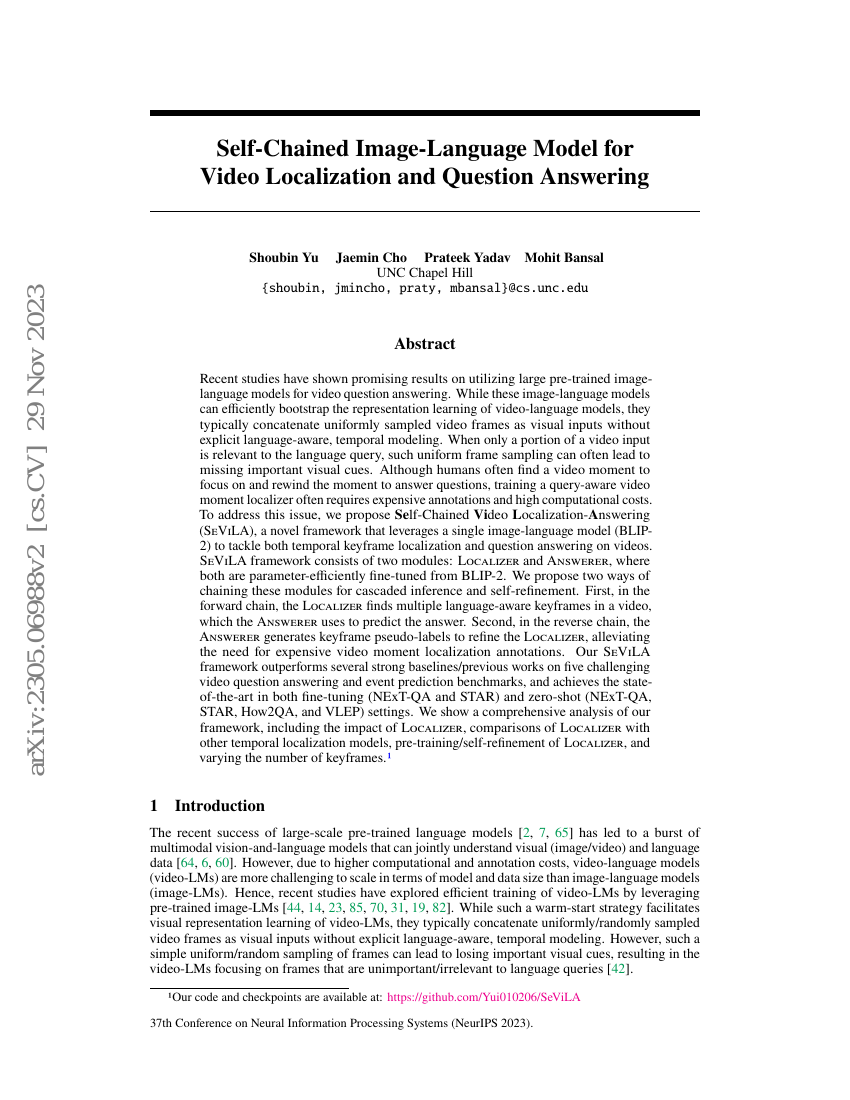Command Palette
Search for a command to run...
Self-Chained Image-Language Model for Video Localization and Question Answering
Shoubin Yu; Jaemin Cho; Prateek Yadav; Mohit Bansal

Abstract
Recent studies have shown promising results on utilizing large pre-trained image-language models for video question answering. While these image-language models can efficiently bootstrap the representation learning of video-language models, they typically concatenate uniformly sampled video frames as visual inputs without explicit language-aware, temporal modeling. When only a portion of a video input is relevant to the language query, such uniform frame sampling can often lead to missing important visual cues. Although humans often find a video moment to focus on and rewind the moment to answer questions, training a query-aware video moment localizer often requires expensive annotations and high computational costs. To address this issue, we propose Self-Chained Video Localization-Answering (SeViLA), a novel framework that leverages a single image-language model (BLIP-2) to tackle both temporal keyframe localization and QA on videos. SeViLA framework consists of two modules: Localizer and Answerer, where both are parameter-efficiently fine-tuned from BLIP-2. We propose two ways of chaining these modules for cascaded inference and self-refinement. First, in the forward chain, the Localizer finds multiple language-aware keyframes in a video, which the Answerer uses to predict the answer. Second, in the reverse chain, the Answerer generates keyframe pseudo-labels to refine the Localizer, alleviating the need for expensive video moment localization annotations. Our SeViLA framework outperforms several strong baselines on 5 challenging video QA and event prediction benchmarks, and achieves the state-of-the-art in both fine-tuning (NExT-QA, STAR) and zero-shot (NExT-QA, STAR, How2QA, VLEP) settings. We also analyze the impact of Localizer, comparisons of Localizer with other temporal localization models, pre-training/self-refinement of Localizer, and varying the number of keyframes.
Code Repositories
Benchmarks
| Benchmark | Methodology | Metrics |
|---|---|---|
| video-question-answering-on-next-qa | SeViLA | Accuracy: 73.8 |
| video-question-answering-on-next-qa-efficient | SeViLA (4 frames) | 1:1 Accuracy: 73.8 |
| video-question-answering-on-situated | SeViLA | Average Accuracy: 64.9 |
| video-question-answering-on-situated | SeViLA (0-shot) | Average Accuracy: 44.6 |
| zero-shot-video-question-answer-on-egoschema | SeViLA (4B) | Accuracy: 25.7 |
| zero-shot-video-question-answer-on-egoschema-1 | SeViLA (4B) | Accuracy: 22.7 |
| zero-shot-video-question-answer-on-intentqa | SeViLA (4B) | Accuracy: 60.9 |
| zero-shot-video-question-answer-on-next-qa | Sevila (4B) | Accuracy: 63.6 |
| zero-shot-video-question-answer-on-tvqa | SEVILA (no speech) | Accuracy: 38.2 |
Build AI with AI
From idea to launch — accelerate your AI development with free AI co-coding, out-of-the-box environment and best price of GPUs.